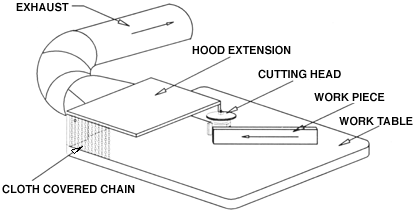Control of Wood Dust From Shapers
1996
DHHS (NIOSH) Publication Number 96-122
Hazard
Wood shapers are a major source of wood dust emissions. Workers exposed to wood dusts have experienced a variety of adverse health effects such as eye and skin irritation, allergy, reduced lung function, asthma, and nasal cancer. Therefore, the National Institute for Occupational Safety and Health* (NIOSH) recommends limiting wood dust exposures to prevent these health problems.
Controls
Surveys by NIOSH researchers found that the dust from wood shapers tends to be poorly controlled. The amount of wood dust emitted was found to depend on the sharpness of the cutter, the depth of the cut, the rate at which the wood is fed into the shaper, and the location of the exhaust hood. After studying the usual hood exhaust placement, researchers developed an improved hood configuration that significantly reduced wood dust emissions.
Modified Exhaust Hood
Wood shaper emissions are usually controlled by an exhaust hood located at the back edge of the work table which allows the operator to freely move the workpiece over the table. Placing the exhaust hood nearer the cutting head would maximize dust collection, however, this would restrict the operator's freedom to move the workpiece. To overcome this problem, a hood extension with a flexible face opening is added. (See ILLUSTRATION) The flexible face opening consists of cloth-covered chains that allow the wood to pass through, but stops the wood dust particles. The extension also increases the hood face velocity by minimizing the open face area. This dust control device is not currently commercially available. Call NIOSH for more information.
*NIOSH is the Federal agency responsible for conducting research and making recommendations for preventing work-related illness and injuries. HAZARD CONTROLS are based on research studies that show reduced worker exposure to hazardous agents or activities.
Illustration: View of Wood Shaper with Hood Extension
A technical article Dust Controls for a Wood Shaper, Appl Ind Hyg J 2(4):164 169(1987), has been published on this subject.
This document is one in a series of seven HAZARD CONTROLS concerning wood dust control techniques listed below that are available free upon request from NIOSH:
- HC4 Control of Wood Dust from Horizontal Belt Sanders
- HC5 Control of Wood Dust from Shapers
- HC6 Control of Wood Dust from Automated Routers
- HC7 Control of Wood Dust from Large Diameter Disc Sanders
- HC8 Control of Wood Dust from Random Orbital Hand Sanders
- HC9 Control of Wood Dust from Orbital Hand Sanders
- HC10 Control of Wood Dust from Table Saws
Acknowledgments
The principal contributors to this HAZARD CONTROLS are Jennifer L. Topmiller, Division of Physical Sciences and Engineering, and Jerome P. Flesch, Education and Information Division, NIOSH.
This document is in the public domain and may be freely copied or reprinted. NIOSH encourages all readers of this HAZARD CONTROLS to make it available to all interested employers and workers.
Control of Wood Dust From Shapers [PDF - 166 KB]
- Page last reviewed: June 6, 2014
- Page last updated: June 6, 2014
- Content source:
- National Institute for Occupational Safety and Health Education and Information Division


 ShareCompartir
ShareCompartir